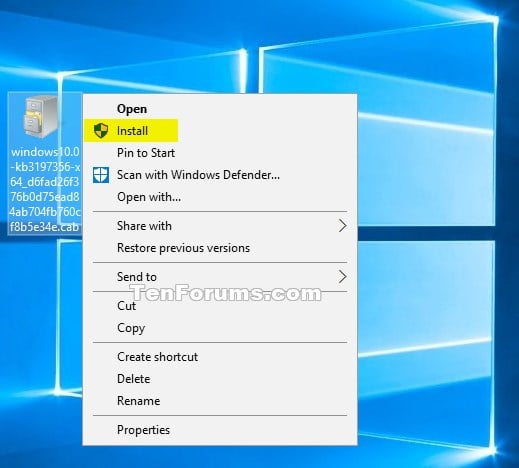
- How to Add or Remove Install CAB Context Menu in Windows 10 A cabinet is a single file, usually with a.cab extension, that stores compressed files in a file library. Some Windows 10 updates are redistributed in the.cab archive format.
- Driver installation from CAB file(s) in Windows (Vista, 7, 8) and Windows Server (2008/2012) Microsoft Windows stores drivers in a designated location which is maintained by the OS through the Windows Plug- and Play Manager.

Step by Step tutorial: How to Install Cumulative updates CAB Files or.msu files on Windows 10 for incremental OS updates and Security patches.
CAB or Cabinet files are compressed files that store data related to various system based installations on a Windows PC. These can also be related to the updates to the OS as well as a driver update. The compression here is based on lossless compression. These .CAB files are also referred to as Diamond Files. They behave in a similar way to .ZIP files. The reason behind this is that they both use Quantum, LZX or DEFLATE compression algorithms to compress the contents inside them. It can hold up to 65,535 CAB folders. It is usually executed by an installer built into Windows 10. This installer extracts they files stored in the Cabinet Archive and executes them one by one. The main recognition of these authentic Cabinet files lies in the first 4 bytes. If you open any authentic CAB file as a text file with your text editors like Notepad or Visual Studio Code, you will see MSCF being the first four letters.
We have earlier seen how to extract CAB File using command line tools, now let us see how to how to create or install Cabinet files on Windows 10.
How to create a CAB File in Windows 10
Creating a CAB file in Windows 10 is not much of a task. There is a program that comes with Windows 10 called as makecab.exe. Now, when you enter commands like,
in the Windows 10 Command Prompt, you will be able to take advantage of the makecab.exe.
With the command given above, the JPG Image stored inside C:files is moved inside of a file called program.cab inside the same path.
How to install a CAB file on Windows 10
There are two methods by which one can install CAB files on Windows 10. The first one uses using the context menus and the second one involves the usage of Command Prompt.
1: Using the Context Menus
This method is fairly simple.
All you need to do is Select the Cabinet File and then Right click on it.
When you see the context menu popping out, just click on Install which is the second option from the top.
Follow the prompts on the screen and you are done.
2: Using the Command Prompt
Start by opening the Command Prompt with Administrator level rights.
Now, type in the following command,
Here, replace <PATH> with the original path of the file.
For example, C:UsersAyushDownloadsCABnew.cab
Now, hit Enter.
If prompted, Reboot your computer by entering Y and then hitting Enter again.
Now, your Cabinet File is executed.
If curious, you can learn more about the Microsoft Cabinet Format at the Microsoft Cabinet Format documentation on MSDN.
TIP: Learn how to to add Install CAB item to the Context Menu.
Related Posts:
SInstall Windows Cab File Windows 2012 Version
ometimes Windows Update may not showing you the updates or hotfixes that you desperately need. In some cases, you may have downloaded update packages that ended with .cab file extension and you need to ‘install’ these .cab files onto the Windows operating system..cab cabinet file format has been used for distribution of updates and hotfixes, but normally it’s packaged within the executable Microsoft Update Standalone Package (MSU) files, with .msu file extension.
Install Windows Server 2012 Iso
If you want to install .cab directly, you can make use of Deployment Image Servicing and Management (DISM) command-line command, which comes built-in in Windows OS beginning from Windows 7 and Windows Server 2008. DISM combines the functions of multiple tools from the Windows Automated Installation Kit (WAIK) and allows users to perform multiple actions on operating system images.
In order to use DISM to install and integrate the package online, open an Admin Command Prompt, and run the following command:
Install Cab File Windows 2012 R2
Change the path and the file name of the .cab file as necessary.
Install Cab Files Windows 10
If you want to avoid restarting Windows after installing the update, try the following command which install the package silent and block any restart attempt: